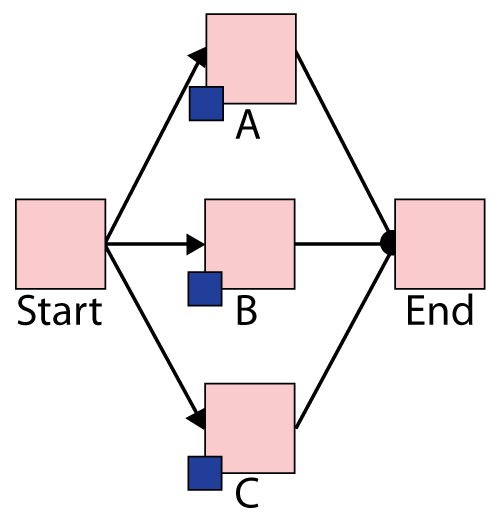Template:Rotation: Difference between revisions
Dingzhou Cao (talk | contribs) No edit summary |
Dingzhou Cao (talk | contribs) No edit summary |
||
| Line 20: | Line 20: | ||
#At 73, Block A fails and activates Block B. | #At 73, Block A fails and activates Block B. | ||
#At 183, Block B fails and activates Block C. | #At 183, Block B fails and activates Block C. | ||
#At 215 | #At 215, Block B is done with repair. At this time, Block C is operating, according to setting, Block B is standby. | ||
#At 238, Block A is done with repair. At this time, Block C is operating. Thus Block A is standby. <br> | |||
#At 349, Block C fails and activates Block A. | |||
#At 396, Block A fails and activates Block B. | |||
#At 398, Block C is done with repair. At this time, Block B is operating. Thus Block C is standby. | |||
#At 432, Block A is done with repair. At this time, Block B is operating. Thus Block A is standby. | |||
#At 506, Block B fails and activates Block C. | |||
#At 515, Block B is done with repair and keep standby because Block C is operating. | |||
#At 536, Block C fails and active Block A. | |||
#At 560, Block A fails and active Block B. | |||
#At 575, Block B fails and put a requset to active Block C. However, Block C is under repiar at the time | |||
[[Category:BlockSim_Examples]] | [[Category:BlockSim_Examples]] | ||
Revision as of 22:09, 20 July 2011
Rotation Example
Description
Three devices A, B and C are in parallel and rotate to perform the task. A is ON initially, B and C are standby. When A fails, Turn B On; when B fails, turn C ON and when C fails, Turn A ON. The desired situation is that, at every moment, one and only one device is operating. This means that, when a device is done with repair, it should be standby if there is already one device operating; or it should be operating when there is not device operating.
BlockSim Solution
The Blocksim modeling of this system is shown in Figure below.
The failures of all three blocks follow Weibull distribution with Beta = 1.5 and Eta = 1000. The repair durations of three blocks follow Weibull distribution with Beta = 1.5 and Eta = 100. After repair, they are as good as new.
Block A belongs to maintenance group 2_A. It has state change trigger. The initial state is ON and the state upon repair is "Default Off Unless overridden". If any item from maintenance group 2_C goes down, then activate this block.
Block B belongs to maintenance group 2_B. It has state change trigger. The initial state is OFF and the state upon repair is "Default Off Unless overridden". If any item from maintenance group 2_A goes down, then activate this block.
Block C belongs to maintenance group 2_C. It has state change trigger. The initial state is OFF and the state upon repair is "Default Off Unless overridden". If any item from maintenance group 2_B goes down, then activate this block.+
Block Up/Down plot
- At 73, Block A fails and activates Block B.
- At 183, Block B fails and activates Block C.
- At 215, Block B is done with repair. At this time, Block C is operating, according to setting, Block B is standby.
- At 238, Block A is done with repair. At this time, Block C is operating. Thus Block A is standby.
- At 349, Block C fails and activates Block A.
- At 396, Block A fails and activates Block B.
- At 398, Block C is done with repair. At this time, Block B is operating. Thus Block C is standby.
- At 432, Block A is done with repair. At this time, Block B is operating. Thus Block A is standby.
- At 506, Block B fails and activates Block C.
- At 515, Block B is done with repair and keep standby because Block C is operating.
- At 536, Block C fails and active Block A.
- At 560, Block A fails and active Block B.
- At 575, Block B fails and put a requset to active Block C. However, Block C is under repiar at the time
